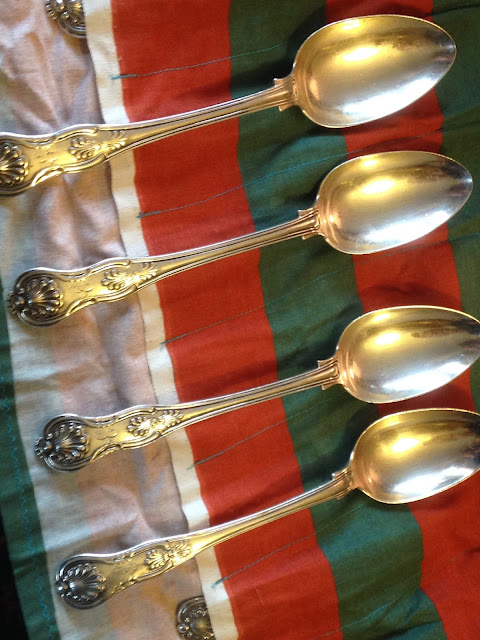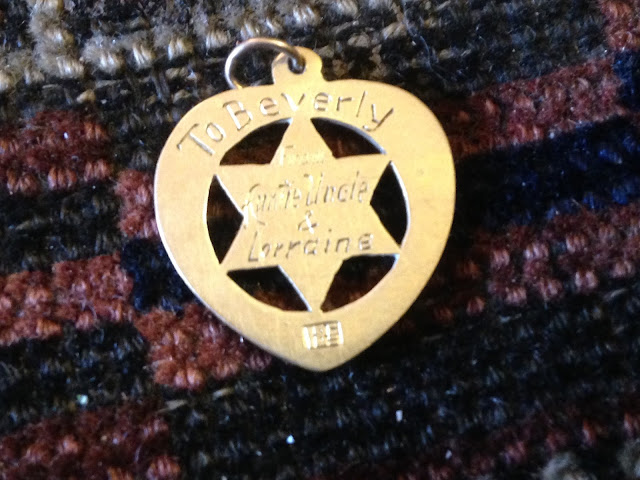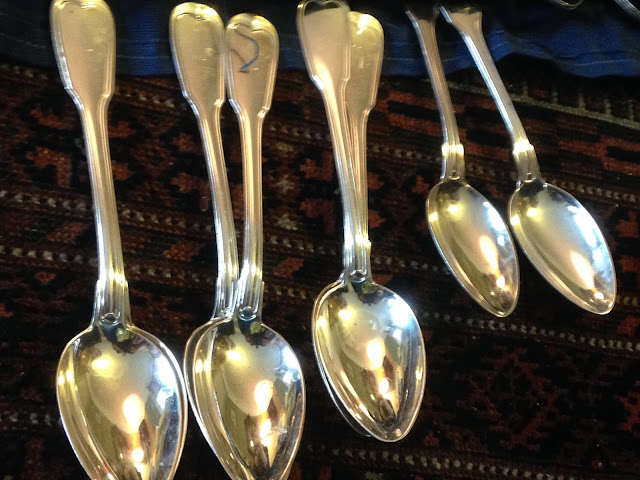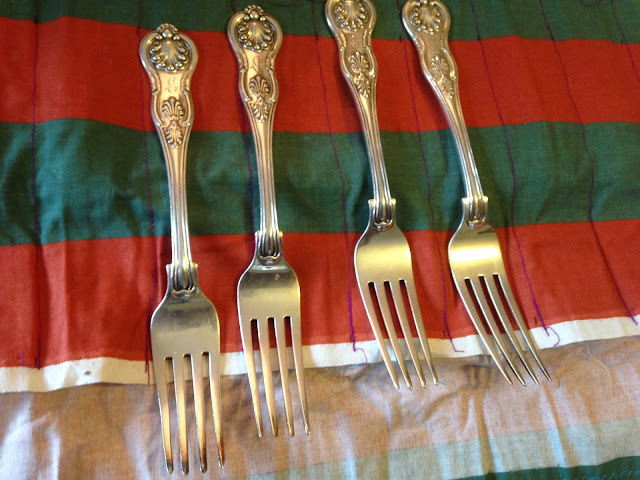I did start my own collection, of British stamps. Some came from letters, as it was in the early 1960s as I recall that commemorative stamps began to be issued on a regular basis. The General Letter Office tercentenary saw that first issue in July 1960 so it was as a ten year old that I launched myself on this first collection.
 |
| The stamp that sparked my interest |
It was soon after this that I discovered a stamp dealer in Yarburgh Street, not far from my home, and just round the corner from Mr Frost the newsagent. I started work as a paperboy at about this time, and spent a fair amount of my wages on buying British postage stamps from him. I remember his small shop, next to a chip shop, his shiny black hair, and I think there was a pall of tobacco smoke too. I built up quite a collection, adding some from family papers, such as revenue stamps from a receipt for a loan given by my great great grandfather Dr Henry Gent in the 1840s or 50s.
 |
| Yarburgh Street, Moss Side. The chip shop and stamp shop were to the extreme right of this photograph. |
I built up an impressive collection. I was especially proud of my coverage of Victorian stamps of all values, including some rarities, such as a first week of issue penny black, still attached to part of its original cover. I think it was dated 5th May, 1840. The whole collection vanished from the bookcase in my parents' front room at some time in the early 1970s. I have no idea who took it.
 |
| Victorian Jubilee stamps. I had most if not all of these. |
 |
| A letter much like my own lost letter, with penny black stamp from 1840. |
 |
| Louis Golding |
When I was researching and writing my MA dissertation for the University of Leicester in 1971 I discovered the book 'Magnolia Street' by the Manchester writer Louis Golding. This dealt with his childhood growing up in Strangeways, the area of north Manchester that was the subject of my dissertation. Over the years I would browse the books in charity shops, that were beginning to appear in England at this time, looking for other books by him that I added to my collection. When the internet arrived, and sites such as addall.com, I was able to add considerably to this collection. I now have over forty volumes by him, most of which I have read. He is forgotten now, but he was very popular in the 1920s, 30s and 40s. I have not added any more books to this collection for quite a while.
 |
| My collection of Louis Golding's books |
It was in the early 1960s that I was working with my father part time in my holidays as a painter and decorator. One job I was given was to scrub all the grease of the ceiling and walls after a chip fan fire in the kitchen of Miss Agnes Wormald of St Werburgh's Road in Chorlton-cum-Hardy. Afterwards she presented me with some gifts: a set of recorders, descant and treble, and scores for Handel's watermusic and fireworks arranged for recorders; I still have all these.
 |
| My wind-up gramophone |
She also gave me a wind-up gramophone and several 78rpm records for classical works. I played these records a lot, along with others that had survived at Manley Road. I played Beethoven's fifth symphony frequently, Fritz Kreisler's Beethoven violin concerto with his remarkable cadenzas, the Schubert Trio played by Casals, Cortot and Thibaud. Older records I inherited at Manley Road included 80rpm recordings, of singers such as Amelita Galli-Curci. I had many old needles, for different volumes, and even some bamboo needles. Over fifty years later I have hundreds of records, many with happy associations and memories, from Snow White to 'O mein Papa', 'My girl's got long hair' to 'Dicitencello vuje'.
It was whilst living in Bideford that I began to collect sandwich plates. These had an association with Sharston Tea Rooms, Iddesleigh Village Hall and tea rooms in Devon. I started picking up these sandwich plates in second-hand shops, and must have two or three dozen now, some of which are going back to charity shops.
 |
| Some of my sandwich plates. |
 |
| More of my sandwich plates. In the middle are two cups and a sugar bowl from my great grandmother's dinner service. |
It must have been in 1970 that I was working in the Christmas holidays at Kendal Milne's department store in Deansgate, Manchester and bought a large Wedgwood fruit bowl for my parents that is still in their home. A few years ago I bought a replica on ebay, and also added a cream jug and an antique Wedgwood milk jug. A year or two ago I bought a silver-rimmed Wedgwood bowl in a darker blue from a charity shop at Tally Ho! Corner in north London. That's a smaller collection than most of mine.
 |
| Some of my Wedgwood. |
I cannot remember exactly how I started my collection of Georgian silver teapots. I now have five, all made by Jewish silversmiths, Emmanuel Levy and his son Simon Levy of Exeter, and Simon Harris of Plymouth. These are not only beautiful but useful, and they are in constant daily use, repaired by the silversmith Neil Bollen.
Related to the teapots are sets of silver cutlery. This started as a collection of silver flatware, or cutlery, made by Simon Levy. The first items were five silver Old English pattern dessert spoons I discovered in an antique shop in Honiton about thirty years ago. I think they cost me £225, relatively much more than I paid for items more recently. This collecting urge was reignited when I discovered some Levy serving spoons for sale in Barnstaple pannier market, stock being cleared by a widow from her husband's shop. I added regularly to this collection. There are lots of serving spoons, not all from Exeter. I now have a complete set for twelve persons of King's pattern, inspired by the six dessert forks in silver gilt that I purchased privately. A set of twelve stunning dinner forks by Simon Levy in Old English bead pattern led to a harlequin full dinner service for twelve in that pattern.
 |
| The Simon Levy table forks. |
 |
| Dessert spoons and fork I added to the set. |
I built up a large collection of silver-plated table forks and spoons in the fiddle and thread pattern made by various French makers, and supplemented these with English dinner knives, all large item which feel good in the hands for eating. This fiddle and thread pattern then inspired a huge collection for twelve person in solid silver. I acquired at very low cost a partial service from America, but added to this some stunning heavy English Georgian forks and spoons, and a large and beautiful French soup ladle.
 |
| French silver-plated fiddle and thread cutlery for everyday use. |
I have various other items, such as those with a Trieste connection, the set for six silver pastry knives and forks that I bought from South America. I have a charming set for twelve people of silver-plated fruit knives and forks in their original box (one knife is different) which are fun to use in the Italian manner. I should not forget the set of stainless steel cutlery in the Old English thread pattern that was a gift to me and Brana from my grandfather in Italy for our wedding. Some items went astray at pop festivals, but it still remains a valued everyday set.
 |
| A wedding present from my grandfather in Italy: high quality stainless steel cutlery. |
I cannot remember how my large collection of silver coin dishes started. These are circular dishes in the middle of which is set a silver coin. These were fun to collect, and the coins come from all over the world. The coins would not be suitable for a coin collector, but they are fascinating nevertheless.
 |
| My silver coin dishes. |
I do have one item that was made by my great great great grandfather the silversmith Samson Schiff, who was born in Mannheim, lived for a few years in Trieste, and spent the remainder of his life in Milan. This came 'married' inappropriately to a large and heavy candelabrum. I found a new base for the candelabrum in a very appropriate classical style, and had the candlestick repaired, again by Neil Bollen,
 |
| Candlestick by Samson Schiff. |
I have one collection of coins, reflecting my strong connection over more than a decade with north east Italy. These are coins of the former Imperial county of Gorizia and Gradisca, and cover a period from the sixteenth to the nineteenth century, but are mostly bronze coins of the eighteenth century. I have five examples of the beautiful silver 15 soldi coin of 1802.
 |
| My collection of coins from Gorizia. |
 |
| 1 soldo coins and two 15 soldi coins. |
 |
| Two very early Gorizia coins, one a rare 'mule', and 1 soldo of 1770 |
Also reflecting this interest in the history of Trieste and Gorizia is my collection of letters of historical interest from these cities covering the period of the eighteenth and nineteenth centuries. I especially like the letters written by Marco Greppi in the 1770s and had hoped to publish these on the internet. All the letters give us a glimpse of aspects of life and commerce in the past.
 |
| Early letters of Gorizia and Trieste. |
The Hierschel family of Trieste inspired another collection: the work of the Trieste-born artist Gioacchino Hierschel de Minerbi, who spent his later years in London, a friend of the Schiff cousins who settled there from Trieste. He painted under the name Van Hier, a reflection of his time painting in the Netherlands. I have a small painting by him that I would classify as a 'potboiler', something he painted, probably in quantities, to earn a little money in his later life. In a few days I shall collect an early painting by him of an alpine scene that I acquired from America that has just been framed. I also have a large oil painting by him from a much later period of his life of fishing boats in early morning mist, but I also have a very large collection of postcards of scenes painted by him and published by Raphael Tuck at the end of the nineteenth century. These appear to have been very popular, and were sold throughout Europe. Creating a website about him allowed me to discover many more original works by him in private and public hands. Two fine paintings were sold by the National Museum of Wales on ebay but at prices I could not afford.
 |
| A small painting by Van Hier. |
 |
| Alpine scene by Van Hier. |
 |
| Fishing boats in morning mist by Van Hier. |
 |
| My two albums of Van Hier postcards. |
I have always been fascinated by clocks, starting with a Vienna regulator that hung in my parents' council house when I was very young. I was fascinated by the longcase clock in my great grandmother's home, Sharston Farm. When I was thirteen our neighbour, Mr Leopold Lorant died. I had befriended him, and visited him in hospital. He requested that after his death I be given the old and dishevelled longcase clock by Richard Hampson of Warrington, dating from about 1750. The clock came back to me when my parents left Manley Road thirty years ago, and I eventually had the case and works fully restored by Musgrave Bickford Antiques in Crediton.
 |
| Longcase clock by Richard Hampson of Warrington. |
I also have a late eighteenth-century London bracket clock by Samuel Meriton, and a marble chiming French clock that I bought at an auction at Northam near Bideford in the early 1980s. This is very similar to the marble French clock that lived on the mantlepiece at Sharston Farm, then lived on the mantlepiece at Dowland Mill, home of my Aunt Lyn. Eventually it came to me, until I gave it to my son and it now lives on the kitchen mantlepiece at his home in Ladywell near Lewisham.
 |
| Mother's clock on Lyn's mantelpiece at Dowland Mill. |
 |
| Late eighteenth-century bracket clock by Samuel Meriton of London. |
Cuckoo clocks always fascinated me, and one that was given to my Aunt Lyn as a wedding present by my parents - or it may have been by my mother's parents - I did have repaired, but they are quite fragile, and it did not work for very long. I still have a modern skeleton pendulum clock that also hasn't worked for years. It lives in my attic workroom, together with the works of a late eighteenth century longcase clock that came from Plas Iago on Anglesey. The owner had a dozen longcase clocks in this large house, but sadly all the cases were burnt when the house was sold. I have another painted dial works from the same venue. When I lived in St Albans I had both these works restored and new hands made, but they have never been in use. I do have a fine French comtoise clock that I bought from my friend Jon Vigor, and it lives in my lodge in the garden.
 |
| My Aunt Lyn's cuckoo clock. |
 |
| Comtoise longcase clock. |
In my kitchen I have a fusee clock that I rescued from under the stairs at Exeter Synagogue when I was clearing it out. It was presented to the synagogue in 1922, but when I found it the wooden frame was detached in pieces, it lacked a pendulum, and the glass door was smashed. This too was repaired and restored by Musgrave Bickford Antiques and it continues to work, on the wall of our kitchen.
 |
| Fusee clock with commemorative label for 1922. |
When I was a teenager my eldest sister gave me a small, simple French clock in a chinoiserie style wooden case that she found in in her home in Railway Street, Gorton, when she moved in. I had this repaired, and eventually I handed it to her when she requested its return.
I have a small collection of cow-shaped milk jugs, inspired by the Burleigh jug at my son's, which was sadly broken. I bought him a new one as a gift, but then built up a collection of my own.
 |
| Cow milk jugs. |
 |
| Some of my Arab brass trays. |
Similar to this collection are the ornamental plates we bought in Jerusalem twenty years ago, and which was supplemented by plates from Turkey, Deruta and charity shops.
 |
| Middle Eastern plates from jerusalem and Turkey; also Italy and Morocco. |
Ginger jard were a recent passion, collected mostly from charity shops to house my collection of teas.
 |
| Ginger jars. |
 |
| Ginger jars. |
I have also built up collections of crockery. We inherited a Paragon Enchantment dinner service from my mother in law. I had already considerably enlarged it following a purchase in an All Aboard charity shop in London, but I bought many more items through ebay.
Starting from one plate in the design Sultana by Johnson's that I remembered from my grandmother's, I bought six soup plates in a charity shop in Exeter. Later I added six more soup plates, vegetable dishes, serving dishes, side plates, salad plates and a few other items from ebay.
 |
| Johnson's 'Sultana'. |
When we lived in our cottage in France we made a trip to Sablé were we bought two breakfast cups and saucers, and a milk jug, in the Mon Jardin design by Villeroy and Boch, as a gift for Brana's parents. This too I have enlarged since the items came back to us, with a dozen dinner plates, side plates, mugs and saucers, a butter dish with cover and a cake stand. I love the design on this set.
 |
| 'Mon Jardin' by Villeroy and Boch. |
My favourite is a design by Wedgwood called Roberts Spray. There are dinner plates, side plates, vegetable dishes, serving dishes and a little dish. Curiously it seems to have been sold only in France and the United States. All these sets of crockery are in regular use, like the teapots and silverware.
 |
| Wedgwood's 'Roberts Spray'. |
 |
| Mongolfier |
 |
| Adderley 'Old Willow' |
I have a particular liking for Adderley 'Old Willow' pattern. This started with coffee cups and saucers from a shop in Crediton, and which I added to. It feels perfect for use in the lodge in the garden, a building with many objects that recreate happy memories, of our cottage in France as well as over a hundred years of memories housed in the Devonshire bobbin dresser.
I do have sundry 'treasures' that I have collected. A pottery sheep was my reward for helping my grandmother clear my great grandmother's final home. A pewter tumbler from Germany carries Randle's name on the bottom. There is a Bohemian china tumbler with a picture of the winter gardens in Southport, which I think was also my great grandmother's. I have a small Ming dynasty dish that I purchased.
 |
| Pewter tumbler, sheep fairing, lead canary, Ming dish and Bohemian tumbler. |
There is a painting I purchased by Arturo Finazzer (1893-1953) of Trieste showing a village in the foothills of the Dolomites, that reminds me of Fanna, where we spent a holiday in my half uncle Dino's cottage.
 |
| Painting by Arturo Finazzer. |
My favourite treasure though has to be the Sumerian cuneiform tablet from Ur of the Chaldees and dated c.2,400 BC. This was given to me by Miss Nellie Gronno of 31, Manley Road, Whalley Range, one of my father's customers who befriended me in the 1960s. It was originally given to her father, Arthur Charles Gronno, né Gronnowski, and one time headmaster of Burgess St School in Manchester, the donor being a former pupil of the school who had served in Mesopotamia during the first world war. I always got a frisson holding something from Ur (I read Sir Leonard Woolley's book Ur of the Chaldees) that was approximately contemporaneous with my likely ancestor the patriarch Abraham.
 |
| Cuneiform tablet. |
 |
| Cuneiform tablet. |
A prized possession is a sefer torah that I purchased a few years ago. With it I have a megillat Esther, which was once in the possession of the Anglican priest and hymn writer Athelstan Riley in 1890.
 |
| Torah mantle. The date tashlaz is 737CE. |
 |
| The text of the scroll. |
 |
| Russian yad, or pointer. |
 |
| Megillat Esther, or scroll of Esther, read at Purim. |
One small collection I have built up over the years is of family wedding photographs, of ourselves. our children, our parents, grandparents and even great grandparents. My collecting started because of my sense of family which developed very early, and these photographs represent that.
Other Items
 |
| A beaded needle case that may have belonged to Mary Sarah Gent |
 |
| My grandfather's 21st birthday present: a silver vesta case. |
 |
| Dr Henry Gent's silver pocket watch |
 |
| The inside of the watch with his name: 'H. Gent' |
 |
| A pocket lens - from the Gent family |
 |
| A camoe pin - from the Gent family |
 |
| Two gold sovereigns in a gold mount |
 |
| My collection of items in horn and bone. |
 |
| WWII medals I bought for my father before obtaining his official set |
 |
| A necklace of black pearls that I think belonged to Laura |
 |
| The back of the sovereigns brooch |
 |
| Pocket watches I have bought |
 |
| Pocket watch by Emanuel Levy of Exeter |
 |
| Pocket watch by William Rawlings Sobey of Exeter |
 |
| Add caption |
 |
| Fobs I purchased in Exeter as a student |
 |
| Sundry chains and pendants, including magen davids. |
 |
| A collection of threepenny bits I made as a teenager |
 |
| A collection of farthings I made as a teenager |
 |
| Sundry banknotes acquired over the years |
 |
| An old one pound note from zeideh |
 |
| A gift from Nadia, I believe |
 |
| Lace bobbins. The top two I purchased in Bruges when ten years old |
 |
| Brana's rings. from me, her mother, and my maternal grandmother |
 |
| My grandmother's ring. I bel;ieve it is citrine. |
 |
| Laura's ring |
 |
| A ring I bought fro Brana in St Albans |
 |
| Laura's ring |
 |
| Gold mostly from Laura |
 |
| A gold bracelet of Laura's |
 |
| Laura's charm bracelet |
 |
| Laura's gold chai and chain |
 |
| The amulet that Laura wore, in the form of a mezuzah. I believe she called it a kemayah. |
 |
| Magen David given to Brana at her birth by her uncle Aleck, auntie Annie, and cousin Lorraine |
 |
| Two silver necklaces, for Lili and for Brana |
 |
| A magen david and a pendant |
 |
| A coral earing |
 |
| A small part of my very large harlequin canteen of silver fiddle and thread flatware |
 |
| part of my canteens of fiddle and old English flatware |
 |
| King's pattern canteen for twelve |
 |
| Emmanuel Levy old English bead: part of a harlequin canteen for twelve |




































No comments:
Post a Comment